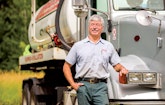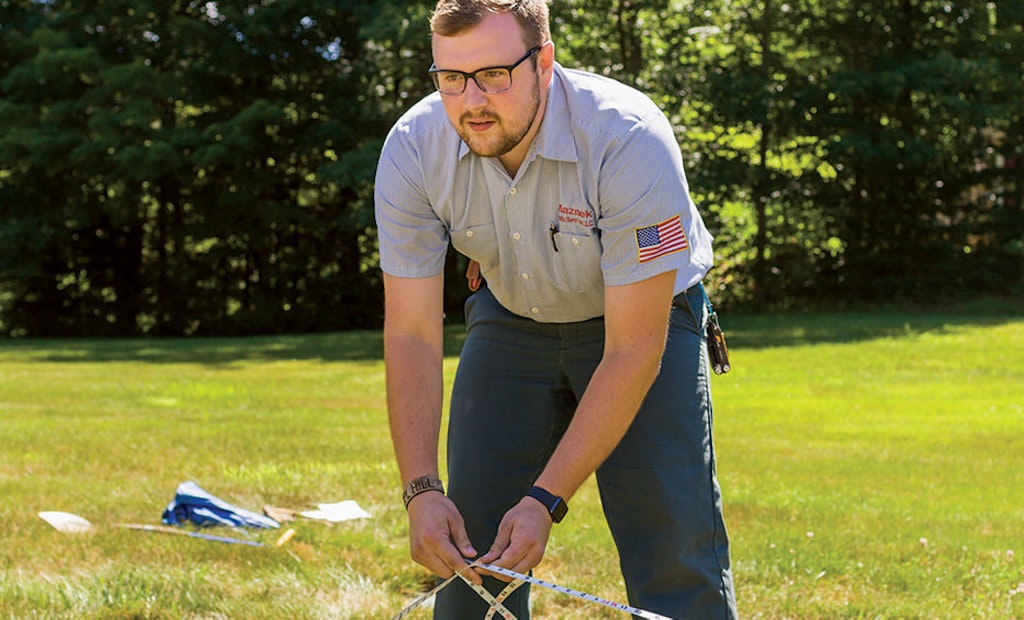Property owners who call on Maznek Septic Service likely get more than they expect.
They don’t just see someone drive up in a big tank truck, deploy and retrieve a hose and pull away. Their tank gets a thorough cleaning. Afterward they get a full report that shows the tank lid’s exact location in the yard and an estimate of how soon to have the tank pumped again, based on a measurement of the sludge layer.
Based in Bedford, New Hampshire, just southwest of Manchester, Maznek Septic Service also performs numerous septic system evaluations for home sales, with the same attention to detail and based on state-mandated protocols. Grease trap pumping contributes substantially to the company’s revenue.
Larry and Patrice Maznek own the business, annually handling some 1.5 million gallons of septage, more than 200,000 gallons of grease and almost 300 system evaluations, with help from technician Trace Uhlinger (Patrice’s son) and administrative assistant Crystal Uhlinger.
Larry Maznek launched the business in 2011 after 32 years as a union carpenter. It has grown largely through referrals generated by business networking and active roles in the Granite State Designers and Installers Association (GSDIA) and the New Hampshire Association of Septage Haulers (NHASH).
A SECOND CAREER
Maznek was born in Holyoke, Massachusetts, but raised in Manchester; he has lived in Bedford for the past 27 years. After high school in Manchester, he enrolled in a four-year apprenticeship with the carpenters’ union and emerged as a foreman.
For the next 28 years, he supervised projects for a major commercial construction company, Central Ceilings and Partitions. He worked mostly around Boston; his projects included renovations at Fenway Park, the Boston Garden and Boston Logan International Airport, leading crews of five to 15 people.
In 1990, he contemplated going into business as a homebuilder, so he acquired his septic system designer and installer licenses. “Then we had a housing crash,” he recalls. “I didn’t dare go out on my own. In the carpenters’ union, you’re eligible to retire after 30 years, so after 15 years you’re going to stay with it and get your pension. That’s what I did. We called it the golden handcuffs. I actually stayed in for 32 years.”
He did acquire the continuing education units he needed to keep the onsite licenses. When he decided to become a septic pumper after retirement, he started with the design for a truck. His vision was a vacuum truck that could do double duty for hauling construction site material. To that end, he hired Amthor International to outfit a 2005 Peterbilt 378 roll-off container rig with a 4,100-gallon steel tank and National Vacuum Equipment Challenger 866 pump. (It was the 2015 Pumper Classy Truck of the Year.)
“It still runs like a top,” Maznek says. The truck’s hydraulic mechanism enables him to tilt the tank to empty it of settled solids. To convert for occasional hauling of material, Maznek drives to a container rental company, drops off the tank, picks up a container and goes.
FINE-TUNING FOCUS
The company started out doing both pumping and installations, but it exited the installation business two years ago. “I got too busy with pumping, and Trace was too busy doing evaluations,” Maznek says. “I was leasing an excavator for the installs, and it just wasn’t working out. So we dropped that part of the business.”
All remaining sides of the business are thriving. On the grease trap side, the company serves a major restaurant and butcher shop that accounts for 12,000 gallons of grease every three weeks and 9,000 gallons of septage every four weeks. A large investment firm with a kitchen and cafeteria requires high-volume service every two months.
“For evaluations, if people are willing to pay us, we will go throughout the state of New Hampshire,” Maznek says. He and Uhlinger are state licensed, and they help with the courses for evaluators offered by the GSDIA, of which Maznek is a board member. A 2015 Ford Transit van provides a mobile base for the evaluations.
“The evaluations give us a chance to educate people, first of all,” Maznek says. They use a RIDGID SeeSnake microReel inspection system to examine the line from the tank to the distribution box; the property owners receive the inspection video. They take digital pictures of the tank baffles and include them in the report. A Gen-Eye Hot-Spot pipe locator (General Pipe Cleaners/General Wire Spring) with accompanying sonde comes in handy for precisely locating distribution boxes.
“We triangulate the tank openings, taking measurements off of buildings, not from trees or shrubs,” Maznek says. “We make a scale drawing on graph paper. We do that even if they have a riser to grade, because in winter when there’s a couple feet of snow on the ground, if someone has an emergency, we want to get right to that cover. We keep that information in our database.”
For inspections, they use the microReel system and a Troglotech Trogloprobe T812 pan-and-tilt camera with a head that swivels 180 degrees horizontal and vertical. “That comes in real handy,” Maznek says. “When we go into a distribution box, we can actually look around to see if it’s sound and also level. We don’t even have to open up the D-box after that.”
BUILDING THE BASE
Septic pumping service stays within about 30 miles of home base; that way Maznek is never too far afield if a customer calls with an emergency. He had his truck before he had a clientele, so he had to build the business from scratch. Living in a residential area, he couldn’t store the truck at home. “I went to a storage facility in Bedford and told the lady in the office, ‘I’m just starting a septic business, and I need a place to park my truck.’
“It turned out she was in a Business Networking International group. She said, ‘You’ve got to come see this group.’ At the time I wasn’t overly busy, so I said, ‘Well, OK.’”
The group met every week on Thursday mornings. Members came from a wide range of occupations. “When I started, there were about 40 people from different businesses,” Maznek says. “You give me a plan and I could build a skyscraper, but I didn’t know anything about running a business. I figured if I hung out with businesspeople, something was bound to rub off. They became mentors, but they also gave me a lot of referrals.”
GSDIA and NHASH (of which Maznek is acting president) also provide connections. One GSDIA member, Advanced Onsite Solutions, has been especially helpful: “They liked the way I cleaned the tanks, and they set me up with a few developments for residents over age 55. A couple of people on the boards of those developments have referred me to the boards of similar complexes. You never know where you’re going to get your next referral from.”
Significant business also comes from the company website, designed and maintained by Larry Bartlett, that’s heavy on customer education. “It’s pricey, but Patrice and I think it’s well worth it,” Maznek says. “I’m going to be 60 this year, and I wasn’t brought up on computers. I can land an airplane, but I can’t run a computer.”
DOING IT RIGHT
Then there’s good old word-of-mouth, and that comes from service with a difference that customers notice. “I explain to them how the tank works,” Maznek says. “If you start with a 1,000-gallon tank, you have 999 gallons of space before water gets pushed out to the drainfield. As the solids build up, that 1,000-gallon tank becomes in effect a 900-gallon tank and then an 800-gallon tank. When it gets a quarter full, with 250 gallons of sludge, you want to pump that sludge out and get back to 1,000-gallon capacity.”
To get a good handle on capacity, they use a TruCore sludge sampler (Sim/Tech Filter). “There’s no way you can just look into the tank and say it’s a quarter full.” The measured sludge level tells Maznek how quickly the tank is filling up and enables him to recommend the optimum pumping interval: “If it has been two years and the tank is only an eighth full, we’re going to tell them to pump it in four years. If they’re at three-eighths, we’re going to tell them to pump more often.”
Maznek stirs tanks thoroughly using a Crust Busters tank agitator; he considers that less time-consuming, more effective and safer than backwashing tanks from the truck.
“Before I start pumping, I note the level of the effluent,” he says. “That tells me whether the field is taking it or whether there’s a leak in the tank. I pump the tank down halfway and then inspect the baffle. Then I use the Crust Buster to reach into the corners of the tank, bring everything into the center and stir that all up. Then I pump the tank down the rest of the way. We take as much of the solids and liquid as possible out of the tank.
“I’ve had customers ask why I don’t leave some in there to get the bacteria going. I tell them, ‘When you change the oil in your car, you don’t put a quart of dirty oil back in with 3 quarts of new.’ People can relate to car and automotive analogies. The human body is a bacterial factory. The first time you flush the toilet, you’ve jump-started the bacteria.”
ON THE HORIZON
Looking ahead, the Mazneks see growth continuing through referrals and repeat business. They’re looking to buy another vacuum truck in the near future — a more traditional unit instead of another roll-off configuration. There’s less need now for moving earth and more for moving liquids, and that’s just fine.
Taking flight
Larry Maznek’s father was a navigator on a B-17 Flying Fortress bomber during World War II. Maznek must have inherited the flying gene: He became a pilot in 2008 and often flies a rented Cessna 172 wingover, single-engine, four-seat airplane.
Maznek is licensed to fly aircraft with retractable landing gear and a variable-speed, variable-pitch propeller. The plane is kept at the airport in Nashua, New Hampshire, where Maznek took flight lessons from certified flight instructor Steve Brouillette of Brouillette Aviation.
He’s a frequent visitor to the EAA AirVenture fly-in in Oshkosh, Wisconsin, a weeklong summer event known as the World’s Greatest Aviation Celebration. Maznek flies purely for pleasure and enjoys taking people up for their first flights. He has given rides in the Cessna to former members of Pop Warner football teams, which he used to coach. “A couple of them have become pilots,” he says.
Arguably his most memorable flight came about three years ago on a first date with Patrice Maznek, the woman who a year later became his wife. “I met her at the airport,” Larry recalls. “She was working at the pilot shop. I went in with a pilot buddy of mine to buy a chart. There was only one left. I had my buddy take the chart so I could go back in and get a date.”
Patrice recalls, “I was the only one in the shop that day. I came sashaying down the aisle in red cowboy boots and Wrangler jeans with my ponytail swinging from side to side. That’s how we met. He says it was love at first sight.”
For that first date, he took her on a flight that covered parts of four states. And the rest, as they say, is history.












